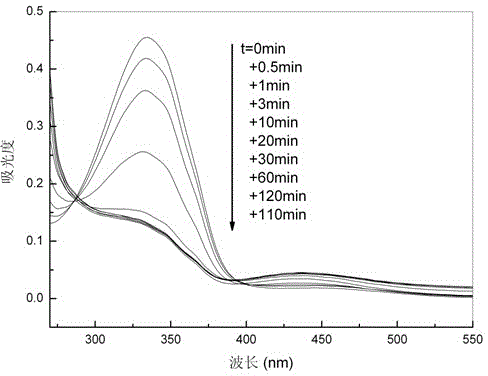A kind of preparation method and application of hyperbranched azo polymer
A technology of azo polymers and polymers, applied in chemical instruments and methods, color-changing fluorescent materials, etc., can solve the problem of low photoisomerization response rate and degree, and achieve the effect of low driving power
- Summary
- Abstract
- Description
- Claims
- Application Information
AI Technical Summary
Problems solved by technology
Method used
Image
Examples
Embodiment 1
[0026] Add 3g p-nitrobenzoic acid, 9g sodium hydroxide and 9mL water to a 250mL three-necked flask equipped with a stir bar, stir well and raise the temperature to 35℃; dissolve 21g glucose in 50mL water and add it dropwise within 10min In a three-necked flask, the reaction was maintained at 35°C for 30 minutes, and then the temperature was lowered to 10°C and the reaction continued for 45 minutes. Pour the reaction solution into a beaker, cool it, neutralize it with dilute hydrochloric acid to pH=0.5, and then suction and filter the mixture to obtain a yellow solid; dissolve the solid with sodium hydroxide solution, then add hydrochloric acid for acidification, and a solid is precipitated After suction filtration and washing with water to obtain a yellow solid, put it into the oven to dry.
[0027] In a 100 mL round bottom flask was added 2 g of the above yellow solid, 0.45 g of thionyl chloride, 2 mL of N,N'-dimethylformamide and 10 g of acetone, and refluxed at 60°C for 9 hour...
Embodiment 2
[0030] Add 3g of p-nitrobenzoic acid, 15g of sodium hydroxide and 60mL of water to a 250mL three-necked flask equipped with a stir bar, stir well and raise the temperature to 65℃; dissolve 27g of glucose in 50mL of water and add it dropwise within 2h In a three-necked flask, the temperature was maintained at 65°C for 2h, and then the temperature was lowered to 20°C and the reaction continued for 2h. Pour the reaction solution into a beaker, cool it, neutralize it with acetic acid to pH=7, and then suction filter the mixed solution to obtain a yellow solid; dissolve the solid with ammonium bicarbonate solution, then add acetic acid for acidification, and a solid is precipitated. After suction filtration and washing with water, a yellow solid was obtained, which was placed in an oven to dry.
[0031] Add 2g of the above yellow solid, 4.5g of thionyl chloride, 10mL of N,N'-dimethylformamide and 40g of ethanol into a 100mL round bottom flask, and reflux at 80°C for 15h. After the re...
Embodiment 3
[0034] Add 3g p-nitrobenzoic acid, 11g sodium hydroxide and 40mL water in a 250mL three-necked flask equipped with a stir bar, stir well and raise the temperature to 50℃; dissolve 25g glucose in 50mL water and add dropwise within 30min In a three-necked flask, the temperature was maintained at 50°C for 1 hour, and then the temperature was lowered to 15°C and the reaction continued for 1 hour. Pour the reaction solution into a beaker, cool it, neutralize it with acetic acid to pH=5, and then suction filter the mixed solution to obtain a yellow solid; dissolve the solid with potassium carbonate solution, then add acetic acid for acidification, and precipitate a solid. After filtering and washing with water, a yellow solid was obtained, which was placed in an oven to dry.
[0035] In a 100 mL round bottom flask were added 2 g of the above yellow solid, 1.8 g of thionyl chloride, 5 mL of N,N'-dimethylformamide and 20 g of ethyl acetate, and refluxed at 65° C. for 11 h. After the rea...
PUM
 Login to View More
Login to View More Abstract
Description
Claims
Application Information
 Login to View More
Login to View More - R&D
- Intellectual Property
- Life Sciences
- Materials
- Tech Scout
- Unparalleled Data Quality
- Higher Quality Content
- 60% Fewer Hallucinations
Browse by: Latest US Patents, China's latest patents, Technical Efficacy Thesaurus, Application Domain, Technology Topic, Popular Technical Reports.
© 2025 PatSnap. All rights reserved.Legal|Privacy policy|Modern Slavery Act Transparency Statement|Sitemap|About US| Contact US: help@patsnap.com

